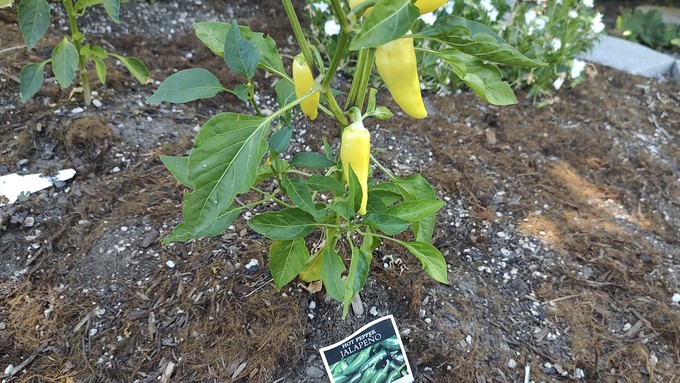
Cool spring challenged seedling growth, no matter the pepper variety

This not-jalapeno is another mislabeled pepper in the summer of #jalapenogate. Laura Litzinger Hafner via Facebook
It’s been a tough summer for peppers – no matter the variety.
First, there’s Jalapenogate. Thousands of gardeners in several states are dealing with mislabeled jalapeno (or purple bell) plants. Instead of producing what their buyers expected, these plants grew yellow fruit that looks like a banana or wax pepper (and definitely not a jalapeno).
“I planted jalapenos, habaneros, serranos, Anaheims, green bells, yellow bells, and red bells,” wrote SDG reader Hollie Snider of Colorado on our Facebook page. “One of my jalapenos appears to be either a golden jalapeno or a Hungarian wax. Another jalapeno appears to be a banana pepper.”
(Read more about Jalapenogate here: https://sacdigsgardening.californialocal.com/article/45405-jalapenogate-is-real/)
It’s not just jalapenos that have had a head-scratching summer; all sorts of peppers have not enjoyed 2023.
The trouble started with the cool spring temperatures, observed Evan Hanson, retail nursery manager at Big Oak Nursery in Elk Grove. “Our spring peppers didn’t grow well. We had a lot of problems with them growing. They just didn’t do anything. As a result, we didn’t have the hot peppers – such as Carolina Reaper and ghost peppers – like we usually do.”
Instead of developing, the baby pepper plants damped off or seemed stunted. It was an issue experienced by other local pepper growers, too.
Big Oak, which grows many of its own veggies from seed, avoided selling the mislabeled jalapenos, at least so far. Nurseries and customers can’t tell for sure until the peppers form fruit. “So far so good,” Hanson said.
But many pepper buyers found out the hard way that their “jalapenos” weren’t what they were labeled. For example, a quick survey of pepper plants at Fremont Community Garden in Midtown Sacramento found several peppers with “jalapeno” plant tags that were clearly bearing pale yellow peppers.
Mixing up pepper seed is an easy mistake, even for experienced growers.
“Pepper seeds look alike,” noted radio host-turned-podcaster Farmer Fred Hoffman, a lifetime UCCE master gardener and host of “Garden Basics with Farmer Fred.”
Pepper seed needs warm temperatures – above 80 degrees – to germinate and warm soil (above 55 degrees) to grow outdoors. That’s why local growers usually start their peppers indoors in February. Pepper seedlings take several weeks of development before they’re ready to transplant outside.
That need for warmth and a long growth period until maturity can make peppers challenging under the best of growing conditions. Although peppers need sun, they’re easily sunburned. The challenge now is to keep them semi-shaded during scorching summer days and evenly irrigated.
For more on peppers, check out these tips from the UCCE master gardeners: https://ipm.ucanr.edu/agriculture/peppers/
Comments
0 comments have been posted.Sacramento Digs Gardening to your inbox.
Food in My Back Yard Series
April 29: What's (already) wrong with my tomato plants?
April 22: Should you stock up on fertilizer? (Yes!)
April 15: Grow culinary herbs in containers
April 8: When to plant summer vegetables
April 1: Don't be fooled by these garden myths
March 25: Fertilizer tips: How to 'feed' your vegetables for healthy growth
March 18: Time to give vegetable seedlings some more space
March 11: Ways to win the fight against weeds
March 4: Potatoes from the garden
Feb. 25: Plant a fruit tree now -- for later
Feb. 18: How to squeeze more food into less space
Feb. 11: When to plant? Consider staggering your transplants
Feb. 4: Starting in seed starting
Sites We Like
Garden Checklist for week of May 4
Enjoy this spring weather – and get gardening!
* Plant, plant, plant! It’s prime planting season in the Sacramento area. Time to set out those tomato transplants along with peppers and eggplants. Pinch off any flowers on new transplants to make them concentrate on establishing roots instead of setting premature fruit.
* Direct-seed melons, cucumbers, summer squash, corn, radishes, pumpkins and annual herbs such as basil.
* Harvest cabbage, lettuce, peas and green onions.
* In the flower garden, direct-seed sunflowers, cosmos, salvia, zinnias, marigolds, celosia and asters. (You also can transplant seedlings for many of the same flowers.)
* Plant dahlia tubers. Other perennials to set out include verbena, coreopsis, coneflower and astilbe.
* Transplant petunias, marigolds and perennial flowers such as astilbe, columbine, coneflowers, coreopsis, dahlias, rudbeckia and verbena.
* Keep an eye out for slugs, snails, earwigs and aphids that want to dine on tender new growth.
* Feed summer bloomers with a balanced fertilizer.
* For continued bloom, cut off spent flowers on roses as well as other flowering plants.
* Add mulch to the garden to maintain moisture. Mulch also cuts down on weeds. But don’t let it mound around the stems or trunks of trees or shrubs. Leave about a 6-inch to 1-foot circle to avoid crown rot or other problems.